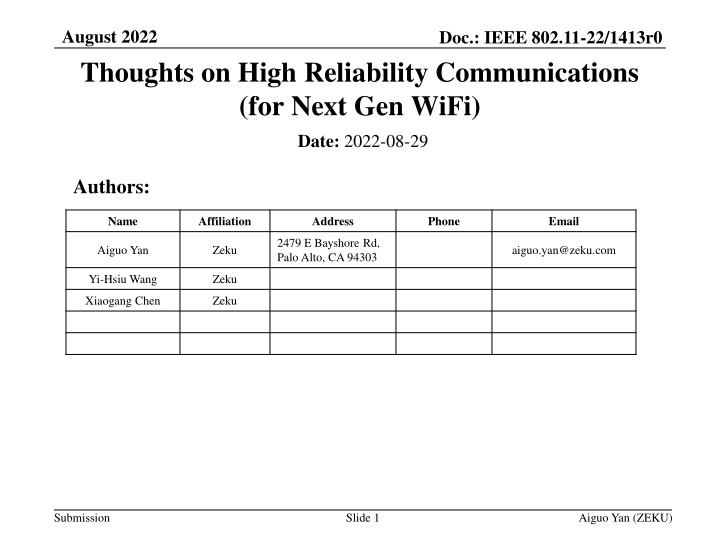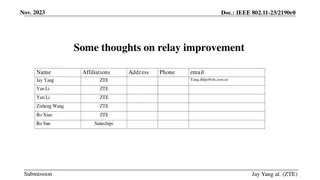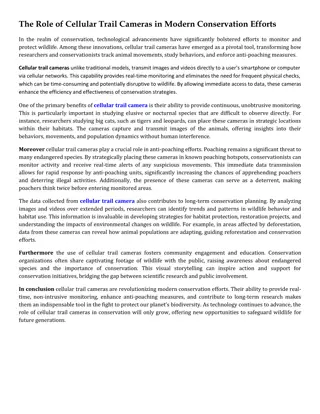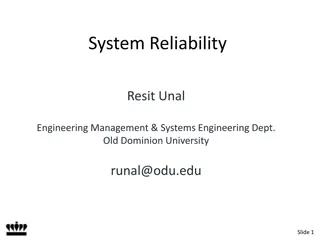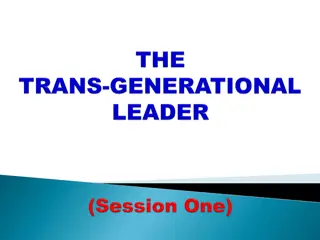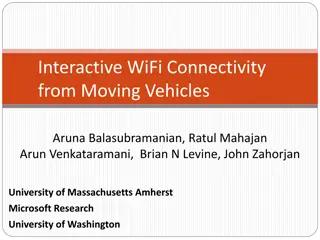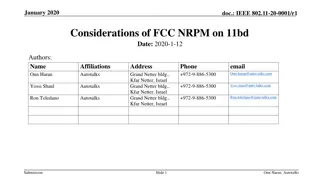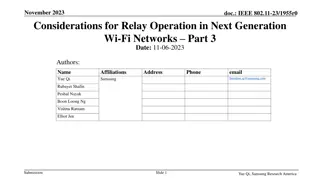Insights on Improving Reliability in Next-Gen WiFi Networks
Delve into enhancing reliability in next-generation WiFi networks through optimization strategies focusing on key areas like MIMO/TXBF concerns, throughput/data rate improvements, and reducing overhead feedback. Explore ways for the WiFi community to collaboratively address existing challenges and innovate for greater network performance and efficiency.
Download Presentation

Please find below an Image/Link to download the presentation.
The content on the website is provided AS IS for your information and personal use only. It may not be sold, licensed, or shared on other websites without obtaining consent from the author.If you encounter any issues during the download, it is possible that the publisher has removed the file from their server.
You are allowed to download the files provided on this website for personal or commercial use, subject to the condition that they are used lawfully. All files are the property of their respective owners.
The content on the website is provided AS IS for your information and personal use only. It may not be sold, licensed, or shared on other websites without obtaining consent from the author.
E N D
Presentation Transcript
August 2022 Doc.: IEEE 802.11-22/1413r0 Thoughts on High Reliability Communications (for Next Gen WiFi) Date: 2022-08-29 Authors: Name Affiliation Address Phone Email 2479 E Bayshore Rd, Palo Alto, CA 94303 Aiguo Yan Zeku aiguo.yan@zeku.com Yi-Hsiu Wang Zeku Xiaogang Chen Zeku Submission Slide 1 Aiguo Yan (ZEKU)
August 2022 Doc.: IEEE 802.11-22/1413r0 Agenda 1. Key Points from past WNG Presentation 2. Area 1 for Improvement 3. Area 2 for Improvement 4. Area 3 for Improvement 5. Summary 6. Straw-Polls Submission Slide 2 Aiguo Yan(ZEKU)
August 2022 Doc.: IEEE 802.11-22/1413r0 Key points from previous WNG meetings Throughput/DataRate, and Latency are two KPIs emphasized by many presenters. Another often emphasized point is Reliability, along with similar KPIs such as QoS, Robustness, Coverage and Efficiency. One presentation [MTK] also emphasized practical throughput improvements instead of theoretic throughput improvements on paper, in general popular usage scenarios instead of some rare usage scenarios. UHR-SG is formed with emphasized on Reliability. One of requirements is performance improvement at different SNR level. More resources (such as Higher TX power, wider channel BW, more antennas, more available spectrum ) can always make a wireless system more reliable. In addition to high cost with these approaches, resources may be unavailable and there are constraints to these resources (regulatory issues and physical size of a device) Question: What could WiFi Community do to optimize existing technology for improving reliability? Slide 3 Submission Aiguo Yan (ZEKU)
August 2022 Doc.: IEEE 802.11-22/1413r0 Area 1: Existing Concerns with MIMO/TXBF 11ax-P579: It is recommended that the spatial mapping matrix applied to HE-STF and beyond be chosen such that it preserves the smoothness of the physical channel, achieved by limiting the variation of each element s real and imaginary values in the spatial mapping matrix across successive tones within one RU 11beD1.5-P652: It is recommended that the spatial mapping matrix applied to EHT-STF and beyond is chosen such that it preserves the smoothness of the physical channel, achieved by limiting the variation of each element's real and imaginary values in the spatial mapping matrix across successive tones within one RU. Call for actions: Could WiFi community define ways for AP/STA work together to better preserves and improve the smoothness of the BFed physical channel? Submission Slide 4 Aiguo Yan (ZEKU)
August 2022 Doc.: IEEE 802.11-22/1413r0 Area 2: TXBF feedback Overhead With more 4K subcarriers (possible more in WiFi8) and 8 TX antennas (possible more in WiFi8), and potential multi-AP schemes in WiFi8, amount of data to be fed-back is enormous Multiple contributions emphasized importance of overhead reduction. [InterDigital]; [Samsung]; [Toshiba] and [Huawei] Recently, CIS Feedback Overhead Reduction was proposed as the top use cases in July AIML TIG meeting Submission Slide 5 Aiguo Yan (ZEKU)
August 2022 Doc.: IEEE 802.11-22/1413r0 Existing Proposals on Overhead Reduction (except Subband [Huawei]/Grassmannian[Toshiba]/DR[Samsung]) Scheme Pros Cons 1 only feedback exists in 802.11ah single data stream only may need additional signaling to identify tap positions and the extra matrix 2 time domain channel exists in 802.11ad/ay Simple improvement from 802.11ax, variant in 11ay simple improvement from 802.11ax Well understood, reduced feedback overhead Well understood, reduced feedback overhead Do not need calibration, reduced feedback overhead 3 Differential Givens Rotation Additional processing, Error Propagation 4 Variable Angle Quantization additional processing 5 Multi-component Feedback May need additional design 6 Codebook based Feedback May need additional design 7 Two way channel training May need additional design 8 Implicit Feedback Simple improvement from 802.11nNeeds calibration Table is from 11-19-0391-00-0eht-feedback-overhead-reduction-in-802-11be.pptx by InterDigital Submission Slide 6 Aiguo Yan (ZEKU)
August 2022 Doc.: IEEE 802.11-22/1413r0 Area 3: GMD based TXBF SVD based TXBF was first introduced in 11n. There are no much changes since then. GMD (Geometric Mean Decomposition) based TXBF has been a hot topic in research community. Question: could the WiFi community conduct more research in this area and standardize the GMD based TXBF scheme, providing gain is significant and complexity increase is acceptable? ( ) : ; is a Diagonal Matrix with T T S s = s H = min , SVD S U H V T M N T T M T M N N T 0 11 TT ( ) H : ; , are unitary Q P GMD R Q H N T P T T M T M N 1/ T T = = = is an upper Triangular Matrix with R 11 r TT r s T T tt = 1 t Submission Slide 7 Aiguo Yan (ZEKU)
August 2022 Doc.: IEEE 802.11-22/1413r0 Summary Use advanced algorithms and additional functionalities supported by standard to further unlock the potential of MIMO technologies Submission Slide 8 Aiguo Yan (ZEKU)
August 2022 Doc.: IEEE 802.11-22/1413r0 SP #1 and #2 1. Are you willing to support enhancement of standard on SVD based TXBF if SNR gain is at least 1.0 dB? 2. Are you willing to support enhancement of standard on SVD based TXBF if SNR gain is around 2.5 dB? Note: Baseline: SVD based TXBF Performance without channel smoothing. These SPs are for Information Collection only. Submission Slide 9 Aiguo Yan (ZEKU)
August 2022 Doc.: IEEE 802.11-22/1413r0 SP #3 and #4 1. Are you willing to support enhancement of standard for SVD TXBF feedback overhead reduction if the amount of data to be feedbacked is reduced to -th, with potential performance degradation <=0.25dB? 2. Are you willing to support enhancement of standard for SVD TXBF feedback overhead reduction if the amount of data to be feedbacked is reduced to 1/4-th, with potential performance degradation <=0.25dB? Note: Baseline: 11be feedback scheme These SPs are for Information Collection only. Submission Slide 10 Aiguo Yan (ZEKU)
August 2022 Doc.: IEEE 802.11-22/1413r0 SP #5 and #6 1. Are you willing to support enhancement of standard for GMD based TXBF if SNR gain is at least 1.0 dB? 2. Are you willing to support enhancement of standard for GMD based TXBF if SNR gain is around 2.5 dB? Note: Baseline: SVD based TXBF Performance. These SPs are for Information Collection only. Submission Slide 11 Aiguo Yan (ZEKU)
August 2022 Doc.: IEEE 802.11-22/1413r0 Selected References WNG Presentations 1. Please see all WNG presentations until July 2022. (inclusive) Overhead Reduction Presentations 1. Key reference: 11-19-0391-00-0eht-feedback-overhead-reduction-in-802-11be.pptx 2. 11-22-0950-02-aiml-discussion-on-interaction-between-ai-ml-wireless-lan.pptx IEEE Journal/Conference Papers on Smoother Channels and GMD 1. C. Shen and M. P. Fitz, "MIMO-OFDM Beamforming for Improved Channel Estimation," in IEEE Journal on Selected Areas in Communications, vol. 26, no. 6, pp. 948-959, August 2008, doi: 10.1109/JSAC.2008.080811. 2. W. Hu, F. Li and Y. Jiang, "Phase Rotations of SVD-Based Precoders in MIMO-OFDM for Improved Channel Estimation," in IEEE Wireless Communications Letters, vol. 10, no. 8, pp. 1805-1809, Aug. 2021, doi: 10.1109/LWC.2021.3081583. 3. E. Jeon, M. Ahn, S. Kim, W. B. Lee and J. Kim, "Joint Beamformer and Beamformee Design for Channel Smoothing in WLAN Systems," 2020 IEEE 92nd Vehicular Technology Conference (VTC2020-Fall), 2020, pp. 1-6, doi: 10.1109/VTC2020-Fall49728.2020.9348441. 4. F. Jiang, Q. Li and X. Chen, "Channel Smoothing for 802.11ax Beamformed MIMO-OFDM," in IEEE Communications Letters, vol. 25, no. 10, pp. 3413-3417, Oct. 2021, doi: 10.1109/LCOMM.2021.3099167. 5. Yi Jiang, J. Li and W. W. Hager, "Joint transceiver design for MIMO communications using geometric mean decomposition," in IEEE Transactions on Signal Processing, vol. 53, no. 10, pp. 3791-3803, Oct. 2005, doi: 10.1109/TSP.2005.855398. Submission Slide 12 Aiguo Yan (ZEKU)
